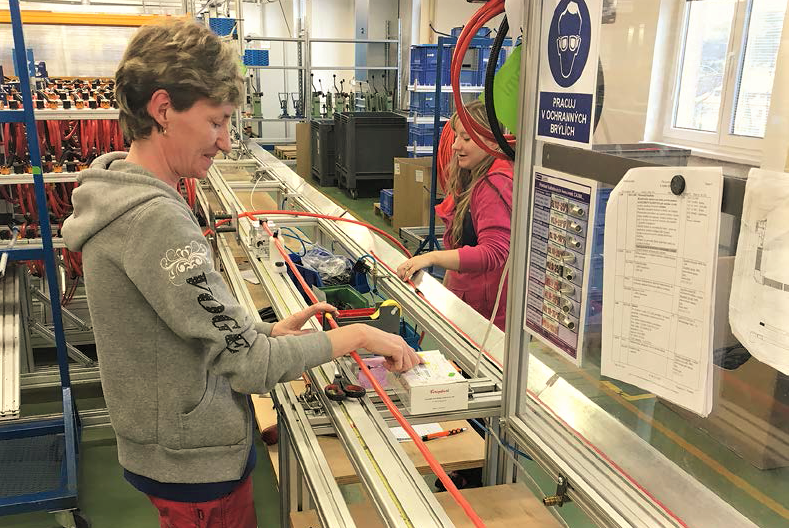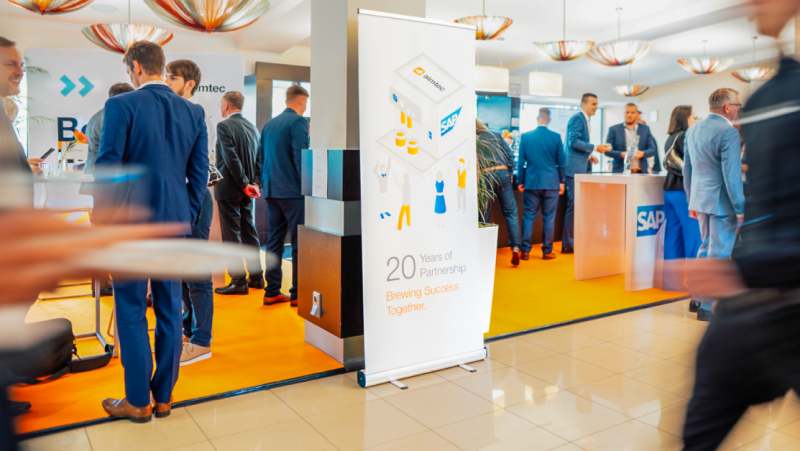Interview with Tomáš Pivovarník, Amphenol‑Tuchel Electronics
- SAP S/4HANA
- Case study
The SappyMES implementation project upon agreed time and financial conditions. Czech branch of the German Amphenol-Tuchel Electronics GmbH company, manufacturing connectors and electrical cable bundles not only for OEMs, implemented the SappyMES system for the production data collection. We interviewed Mr. Tomáš Pivovarník, the plant manager, to learn how the German headquarters evaluates the project after a few months, what the main reasons for the MES system procurement were, and what the expected and real contributions of the solution are.
Can you specify in more details, what is the Amphenol company’s core business, and who are your customers?
The plant in Ostrov falls within the industrial division group of the American Amphenol Corporation company. We produce connectors and cable bundles for industrial usage, for direct customers, or for distributors. John Deere, Philips, Bosch, NSN, or Siemens are among our customers. The concern has about 150 plants all around the world, in Europe, North and South America, China, Asia, and Australia. It employs more than 50 thousand persons, with an annual turnover of 5.34 billion USD. The shares of the company are tradable on the stock exchange. In addition to the industrial division, Amphenol is also focused on automotive, aero, health, or armament segments. We are the second largest company in the world manufacturing connectors. As well as in the automotive industry, quality is important for us, regardless the connector is intended for a defibrillator, robot, or a credit card reader.
How does the production look like in your plant?
The production consists of all types of processes applicable to the cable assortment. We offer an added value to our customers in a form of the final product processing, i.e. the cable bundle, or we only deliver the connector itself. We cut, crimp, and connect cables with the connectors. We either coat it, or spray in injection presses in case of a plastic connector. We also process aluminium castings for the connectors being used in more demanding conditions. We use low pressure and high pressure injection presses, robotic or manual soldering, cutters, presses, assembly and screwing automatic devices.
What were the main reasons for the MES system implementation?
During several last years, we doubled our productivity, and found ourselves in a situation of having thousands of parts in our wide portfolio. We collected data from the production manually, which was really demanding from personal, capacity, and financial points of view. We rested satisfied with a group productivity, and did not deal with details. This procedure was no more satisfactory for us, and two years ago, we started searching for a MES system, which would help us to identify weak processes in the area of productivity, performance, and personnel automatically. Our requirement was to view the levels of individual manufacturing steps, and reveal non-effective downtimes.
What solution did you finally select within your selection procedure?
We were selecting from multiple various MES systems available on the market. We considered development of the existing company SAP system, as well as purchase of an external solution. We refused the latter mentioned alternative, as we did not want to maintain a separate system. The offer of the Aimtec company impressed me most. I met the company representatives before, while working in my previous job in the Toyoda Gosei Czech company. I liked their SappyMES solution for being based on transactions, we use in the SAP ERP. It was no new system or new development transactions. At the same time, the solution is user-friendly. We received consent from the German headquarters to make interventions to the SAP system, and in April, this year, we could start the project.
We are used to hearing frequently, the SAP is a robust, inflexible system. What is your personal experience?
I look at the SAP in a similar way. It is a large scalable system. It is thus crucial how requirements are defined so that the system is implemented in a correct way. People, who do not know the existing processes, are then unable to define, how the system might work better, and often, they transfer the same errors from the old system to the new one. Work is becoming very ineffective. Then, help of consultants, or team of specialists is needed, having vision and experience, being able to advice in this area on an erudite basis.
How does the SappyMES solution work?
Operator has his or her own identification number. Before any operation is started, it is read including the barcode for the order. Thus we have the information in the system, when the employee started the work. After the operation is completed, the person logs off using the touch terminal present at each production line, and enters the number of manufactured pieces, both good and bad ones. Before starting the next operation, the person logs on the order again. The MES system provides data about time, operation duration, and number of good and bad pieces. The MES system also includes information about orders, and knows how long the production of pieces assigned to the operator should approximately take. Everything is directed to the evaluation of the operator’s productivity.
What is the response of operators in production? Do they not perceive the new system as an exaggerated inspection of their work?
Within training of people across the company we teach them how to operate the system. Yes, it is a change. And as such, it is demanding. We all are in the phase of learning. We test the system for what we are able to do with it, or how to develop it further beyond the original task. Even now, we have fine examples of how to modify the current documentation and training of workers.
Can you define major contributions for your production already?
Our expectations definitely met the reality in the MES project. It is decisive for us. We stepped from a black hole, how the production used to appear to us before, to the information about specific product. We know the work in progress state of particular products. At the present phase, we collect data, large amounts of data. It is fundamental for us in these months. Using the data, we will be able to make statistic evaluations. We do not have any real figures yet, as it is a very new project. However, even today, we can see better or worse operations. We can detect the work in progress state of the product, how many hours it will take to complete the product or the order. At the same time, we want to alternate multiple operators of the operations, so that we could see variability in the process. We can also analyse differences between shifts, not only between the operators.
In your headquarters, you were able to enforce an external company to make interventions in the corporate SAP system. How does the German mother company look at the project now, after certain period of time?
Very proudly. They are satisfied that the Czech daughter company was able to cope with the project within a scheduled time, independently, and upon agreed financial conditions. There are many such projects in the SAP area throughout the concern, and not all of them are implemented in such a smooth way. It is possible we will expand this pilot MES project to other plants of the Amphenol company in the future.
What is your vision for next years as to the logistics and production?
We have many plans. We are interested in areas, which might lead to process efficiency improvements, both for the production and the administrative processes. We own all modules in the SAP system, but only few of them are used thoroughly and in the entirety of options. We would like to develop further in the area of quality, data collection directly from machines/production lines, including evaluation and reporting. We require collected data in the production to be transparent, and further usable, such as for the maintenance purposes. Our intention is to search for methods, how to make the data collection system in the maintenance more effective, so that we can know, how often the machines are in downtime, how often they are serviced, how many hours the machines spent being serviced, or which spare parts we consumed, and we want to replace the existing manual records in Excel. We also consider the electronic communication with our suppliers, and capacity planning. On the other hand, any implementation of a system for the sole purpose of obtaining a better graph is not important for us. The important thing is what it really brings and how we can handle the data.
What is your opinion regarding the Industry 4.0? Does it affect you in any way?
Currently, this approach does not affect us very significantly. We used automation of manufacturing and administrative processes and their interconnections even before this initiative was announced. We implement them whenever and wherever it makes sense. In a short-time horizon, it may result in a decrease of the number of job positions, however, in the long-term horizon, the Industry 4.0 will require programmers, engineers, and other coordinators of human and automatic work.
Share article
Top stories from logistics, production and IT.
Subscribe to Aimtec Insights
By registering, you agree to the processing of your personal data by Aimtec as described in the Privacy policy.
Get top stories and articles
from Logistics, Production and IT.
Subscribe to Aimtec Insights
By registering, you agree to the processing of your personal data by Aimtec as described in the Privacy policy.







